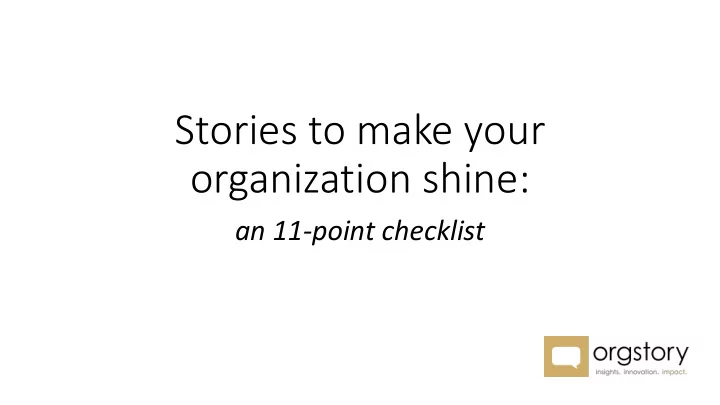

Stories to make your organization shine: an 11-point checklist
Brand Inputs, Influences and Outputs • Inputs: Purpose, Vision, Mission, Values, Competitive Difference • Influences: Perceptions, Experiences • Outputs: Brand Identity, Personality, Voice, Story, Messaging
Brand Platform • Purpose = Why Statement that guides your organization • Vision = Wow Statement that inspires your organization • Mission = What Statement that drives your organization • Values = Weight Statements that ground your organization
11 Point Checklist
#1: Why is now the time to shine? • What are the clear and compelling reasons for reviewing, refining, revising or redirecting your organization’s story? New programs, services, people, leadership, opportunities, need to change current perceptions, need to introduce new identity…why? In no more than 25 words, make the case for making your organization’s story shine
#2: Align your story with your plan • Review your strategic plan priorities and use them as a starting point to make sure your organization’s story is focused, and aligned List the key strategic priorities from your current plan; is your organization connecting each priority in its messaging?
#3: To whom does your story matter most? • Which stakeholders are the most meaningful to reach with updated, refreshed brand stories and messages? In order of priority, list your organization’s most important stakeholder groups
#4: Perception/Reality • For each stakeholder group identified, do you know what they think, know, feel about your organization? Do their perceptions align with your organization’s realities? For each stakeholder group, write how you think they would describe your organization – use phrases, key words, etc. Do these perceptions reflect what they need to know, feel, or think about your organization in order for them to be highly engaged with your organization?
#5: Facts or Feelings? • Are facts preventing an emotional connection with key stakeholders? Review your organization’s communications (brochures, websites, etc.) and make facts connect to feelings – make sure messaging represents outcomes and “howcomes”
#6: What’s your organization’s POD? • Every organization needs a clear point-of-difference to share with each of its stakeholders – internal and external – that resonates with its stakeholders in a manner that they choose your organization over others (think financial support) Complete this sentence: The meaningful difference of our organization is:
#7: What’s your promise? • Your organization’s brand is far more than its logo – what’s its brand promise? Complete this sentence: Our organization promises its key stakeholders…
#8: Words do matter • Using words that represent who your organization is, what it does, why it matters are important; using words that represent the proper tone and personality of your organization are equally important. List 10 words that you think your organization should always use in its story and messaging – then, list 10 words you think it should stop using or never use in its story and messaging
#9: What’s your channel, good buddy • The channels your organization uses to share its message and brand stories are an important part of positioning your brand. There are channels you control (your website); there are channels you don’t (social media). List your organization’s three most important internal and external channels. Audit each to make certain the messages and stories you’re sharing are consistent channel to channel
#10: Who’s your “brand leader”? • Every brand needs a leader – who “owns” your brand to assure its consistency, messaging, impact? Does this person have complete support and buy-in from leadership and board as well as the financial and human capacity required to assure your organization’s brand is a strong asset to support your strategic initiatives? Who “owns” your brand today?
#11: Don’t do it unless you measure it • Like any other activity at your organization, making your story shine must be outcomes-based. With each initiative, with each story, set goals and determine how to measure success against those goals and assess how they are impacting strategic priorities. Donations, awareness, attitudes, perceptions, attendance, employee satisfaction – are just some of the ways to measure your efforts. Keep brand activities accountable by developing a measurement plan
Writing your stories: Message Mapping • Every story has characters, conflict, heroes, and villains. Message Mapping can help set the parameters needed to develop the right stories for the right audiences that lead to the right outcomes.
Next Steps • Use these 11 points to assess your organization’s brand and story • Audit your current efforts • Make a commitment to listen to key stakeholders to help refine and revise your stories and messaging • Align your channels for consistency – internal and external • Make brand and story a “team sport” – everyone’s involvement is important
Recommend
More recommend